Related Research Articles
Locomotive classification on the Pennsylvania Railroad took several forms. Early on, steam locomotives were given single-letter classes. As the 26 letters were quickly assigned, that scheme was abandoned for a more complex system. This was used for all of the PRR's steam locomotives, and — with the exception of the final type bought — all electric locomotives also used this scheme.

The Pennsylvania Railroad K4 was a class of 425 4-6-2 steam locomotives built between 1914 and 1928 for the PRR, where they served as the primary main line passenger steam locomotives on the entire PRR system until 1957.
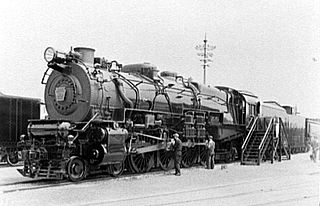
The M1 was a class of steam locomotive of the Pennsylvania Railroad (PRR). It was a class of heavy mixed-traffic locomotives of the 4-8-2 "Mountain" arrangement, which uses four pairs of driving wheels with a four-wheel guiding truck in front for stability at speed and a two-wheel trailing truck to support the large firebox needed for sustained power. Although built for both passenger and freight work, they spent most of their service lives hauling heavy high-speed freight trains. Many PRR men counted the M1 class locomotives as the best steam locomotives the railroad ever owned.
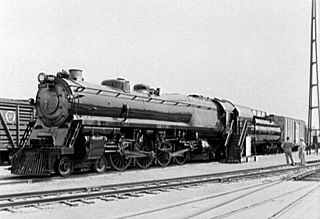
A 4-4-4-4 steam locomotive, in the Whyte notation for describing locomotive wheel arrangements, has a four-wheel leading truck, two sets of four driving wheels, and a four-wheel trailing truck. While it would be possible to make an articulated locomotive of this arrangement, the only 4-4-4-4s ever built were duplex locomotives—with two sets of cylinders driving two sets of driven wheels in one rigid frame, essentially a 4-8-4 with divided drive.
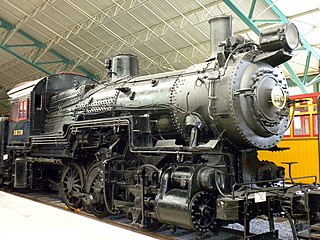
The Pennsylvania Railroad's class B6 was its most successful class of switcher locomotive, or as the PRR termed them "shifter". The PRR preferred the 0-6-0 wheel arrangement for larger switchers, whereas on other railroads the 0-8-0 gained preference. The PRR generally used 2-8-0s when larger power was required.

The PRR S1 class steam locomotive was a single experimental duplex locomotive of the Pennsylvania Railroad. It was designed to demonstrate the advantages of duplex drives espoused by Baldwin Chief Engineer Ralph P. Johnson. The S1 class was the largest steam locomotive ever built. The streamlined Art Deco styled shell of the locomotive was designed by Raymond Loewy.
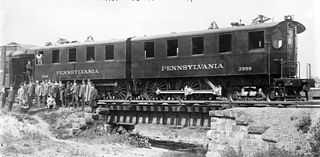
The Pennsylvania Railroad DD1 was a class of boxcab electric locomotives built by the Pennsylvania Railroad. The locomotives were developed as part of the railroad's New York Tunnel Extension, which built the original Pennsylvania Station in New York City and linked it to New Jersey via the North River Tunnels. The Pennsylvania built a total of 66 locomotives in its Altoona Works; they operated in semi-permanently coupled pairs. Westinghouse supplied the electrical equipment.
Pennsylvania Railroad class E2b comprised six experimental B-B electric locomotives built for the railroad by General Electric.
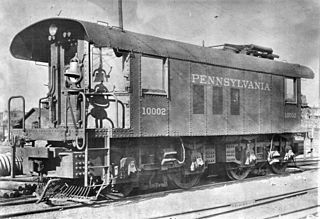
The Pennsylvania Railroad's class AA1 comprised two experimental electric locomotives constructed in 1905 by the company's own Altoona Works with the assistance of Westinghouse. Intended as testbeds as the PRR began its electrification project, both locomotives remained service into the 1930s.

Class D16 on the Pennsylvania Railroad was their final development of the 4-4-0 "American" type of steam locomotive. A total of 429 of these locomotives were built at the PRR's Juniata Shops, spread across five subclasses; some had 80 in (2,030 mm) diameter driving wheels for service in level territory, while others had 68 in (1,730 mm) drivers for mountainous terrain. In the pre-1895 scheme, these locomotives were second class L.
The class D15 of the Pennsylvania Railroad comprised a solitary Lindner-system cross compound steam locomotive of 4-4-0 "American" wheel arrangement in the Whyte notation. The sole locomotive was #1515, built in 1892 at the PRR's Altoona Shops, it had very British lines with a full-length footplate, splashers, a six-wheel tender, and large 84 in (2,134 mm) drivers. It was built in 1892 by the PRR's Altoona Works, and remained in service until it was retired and scrapped in November 1905.
Class E6 on the Pennsylvania Railroad was the final type of 4-4-2 "Atlantic" locomotive built by the railroad, and second only to the Milwaukee Road's streamlined class A in size, speed and power. Although quickly ceding top-flight trains to the larger K4s Pacifics, the E6 remained a popular locomotive on lesser services and some lasted to the end of steam on the PRR. One, #460, called the Lindbergh Engine, is preserved at the Railroad Museum of Pennsylvania. It was moved indoors to begin preparations for restoration on March 17, 2010. On January 10, 2011, PRR #460 was moved to the museum's restoration shop for a two- to three-year project, estimated to cost $350,000. The engine is listed in the National Register of Historic Places.
The PRR class D14 was a 4-4-0 steam locomotive built for the Pennsylvania Railroad. They were originally designated class P in the PRR's pre-1895 classification scheme. Twenty-two locomotives were built at the PRR's Altoona Works ; six in 1893 with 78-inch (1,981 mm) driving wheels, and sixteen in 1894 with 80-inch (2,032 mm) drivers, classified D14a. Later, all sixteen class D14a were rebuilt to class D14b with 68-inch (1,727 mm) drivers for secondary service after they were replaced in top-flight express service, while three of the six class D14 were similarly rebuilt to class D14c.
Class D6 on the Pennsylvania Railroad was a class of 4-4-0 steam locomotive. Nineteen were built by the PRR's Altoona Works between 1881 and 1883. They were equipped with 78-inch (1,981 mm) drivers. Seven were later converted to 72-inch (1,829 mm) drivers and classified D6a.

Pennsylvania Railroad Class L1s were 2-8-2 "Mikado"-type steam locomotives that were used on the Pennsylvania Railroad during the early twentieth century. These 574 locomotives were manufactured between 1914 and 1919 by the railroad's own Juniata Shops as well as the Baldwin Locomotive Works (205) and the Lima Locomotive Works (25).
Class D7 (formerly Class A (anthracite), pre-1895) on the Pennsylvania Railroad was a class of 4-4-0 steam locomotive. Fifty-eight were built by the PRR's Altoona Works (now owned by Norfolk Southern) between 1882–1891 with 68 in (1.73 m) drivers, while sixty-one of class D7a were constructed with 62 in (1.57 m) drivers.

The Pennsylvania Railroad's steam locomotive class D1 comprised thirteen 4-4-0 locomotives for express passenger service, constructed at the railroad's own Altoona Works during 1868–1872. They were the first standardized class of locomotives on the railroad and shared many parts with other standard classes.
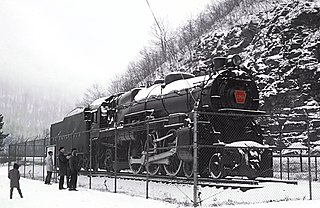
Pennsylvania Railroad 1361 is a 4-6-2 K4 "Pacific" type steam locomotive built in May 1918 by the Pennsylvania Railroad's (PRR) Juniata Shops in Altoona, Pennsylvania. It hauled mainline passenger trains in Pennsylvania and commuter trains in Central New Jersey on the PRR until its retirement from revenue service in 1956. Restored to operating condition for excursion service in 1987, No. 1361 and its only surviving sister locomotive, No. 3750, were designated as the official state steam locomotives by the Pennsylvania General Assembly. In 1988, it was sidelined due to mechanical problems and was currently owned by the Railroaders Memorial Museum (RMM) in Altoona, Pennsylvania, who were currently getting No. 1361 back to operation.
Pennsylvania Railroad 1737 was a 4-6-2 Pacific type K4 class steam locomotive built in 1914 as the first of its class and would haul heavier passenger trains that the smaller E class 4-4-2 Atlantics could not handle such as the PRR's flagship passenger train, the Broadway Limited. In the 1930s, as the PRR had increased passenger service time tables, the trains became longer and heavier than a single K4s could handle, necessitating double-heading with a second engine. The "Standard Railroad Of The World" made attempts to replace the 1737 and its sisters with larger, more powerful classes including: K5, S1, and the T1, none of which were successful; thus, the K4s continued hauling passenger trains until the Pennsylvania Railroad replaced steam locomotives with the increasingly-popular and less-costly diesel-electric locomotives in 1957.
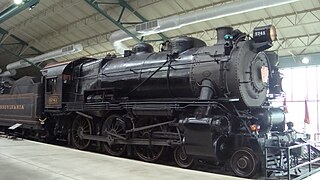
The Pennsylvania Railroad G5 is a class of 4-6-0 steam locomotives built by the PRR's Juniata Shops in the mid-late 1920s. It was designed for passenger trains, particularly on commuter lines, and became a fixture on suburban railroads until the mid-1950s.
References
- 1 2 3 4 5 6 7 8 9 10 Wright, Roydon Vincent; Swift, Porter La Forrest (1912). Locomotive Dictionary: Definitions and Illustrations of American Locomotives, Their Parts and Equipment, Together with Typical Illustrations of Machine Tools and Devices Used in Their Maintenance and Repair. Simmons-Boardman Publishing Company.
- 1 2 3 Test Department, Pennsylvania Railroad (1915). Locomotive Testing Plant at Altoona, Pa: Bulletins. Altoona, Pennsylvania. p. 5.
{{cite book}}: CS1 maint: location missing publisher (link) - 1 2 3 4 Staufer & Pennypacker 1962, p. 146.
- 1 2 3 4 5 6 7 Staufer & Pennypacker 1962, p. 144.
- ↑ Staufer & Pennypacker 1962, p. 159.